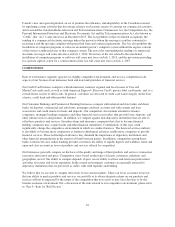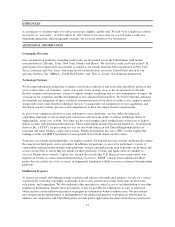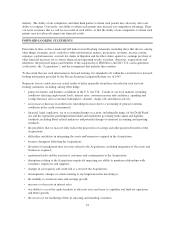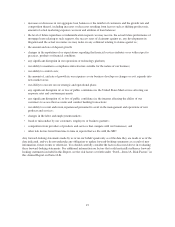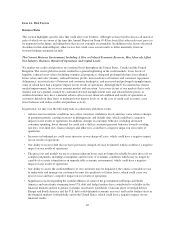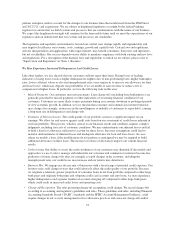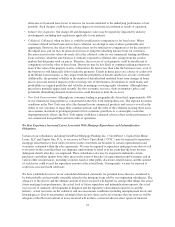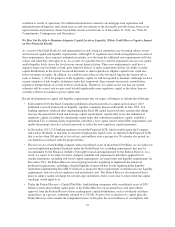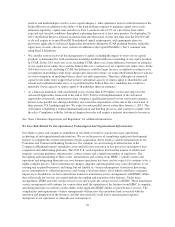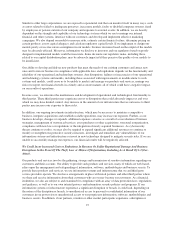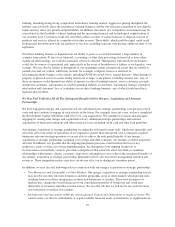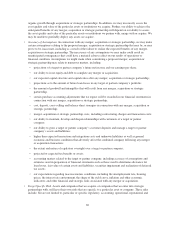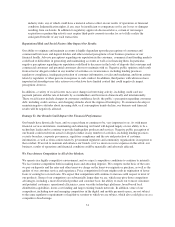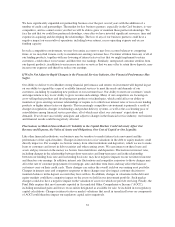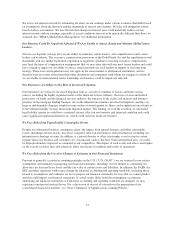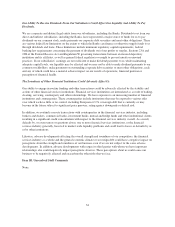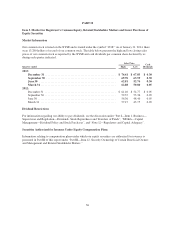Capital One 2013 Annual Report Download - page 46
Download and view the complete annual report
Please find page 46 of the 2013 Capital One annual report below. You can navigate through the pages in the report by either clicking on the pages listed below, or by using the keyword search tool below to find specific information within the annual report.analysis and methodologies used to assess capital adequacy, other qualitative factors at the discretion of the
Federal Reserve in addition to the ability of the bank holding company to maintain capital above each
minimum regulatory capital ratio and above a Tier 1 common ratio of 5% on a pro forma basis under
expected and stressful conditions throughout a planning horizon of at least nine quarters. On September 24,
2013, the Federal Reserve released an interim final rule that stated, for the first time, that the 2014 CCAR
cycle will require us to meet Basel III Standardized capital requirements, with appropriate phase-in
provisions applicable to Advanced Approaches institutions during the CCAR planning horizon, under the
supervisory severely adverse stress scenario in addition to the Capital Plan Rule’s Tier 1 common ratio
using Basel I definitions.
• We consider various factors in the management of capital, including the impact of stress on our capital
position, as determined by both our internal modeling and Federal Reserve modeling of our capital position
in CCAR. In the 2013 stress test cycle, including CCAR, there was a large difference between our estimates
of our capital levels under stress and the Federal Reserve’s estimates of our capital levels under stress. In the
2014 stress test cycle, including CCAR, the difference could be larger because, in addition to using its own
assumptions in modeling credit losses and pre-provision net revenue, we expect the Federal Reserve will use
its own assumptions in modeling balance sheet size and composition. Therefore, although our estimated
capital levels under stress suggest that we have substantial capacity to return capital to shareholders and
remain well capitalized under stress, it is possible that the Federal Reserve’s modeling may result in a
materially lower capacity to return capital to shareholders than our estimates.
• As a financial institution with consolidated assets of more than $250 billion, we became subject to the
Advanced Approaches framework at the end of 2012. Prior to full implementation of the Advanced
Approaches framework, organizations must complete a qualification period of four consecutive quarters,
known as the parallel run, during which they must meet the requirements of the rule to the satisfaction of
their primary U.S. banking regulator. We expect to enter parallel run no earlier than January 1, 2015. This
will require completing a written implementation plan and building processes and systems to comply with
the rules. Compliance with the Advanced Approaches rules will require a material investment of resources.
See “Item 1. Business-Supervision and Regulation” for additional information.
We Face Risk Related To Our Operational, Technological And Organizational Infrastructure.
Our ability to grow and compete is dependent on our ability to build or acquire necessary operational,
technological and organizational infrastructure. We are in the process of completing significant development
projects to complete the systems integration of prior acquisitions and to build a scalable infrastructure in our
Consumer and Commercial Banking businesses. For example, we are investing in infrastructure in the
Commercial Banking business intended to assist with effective execution of key processes and improve loan
origination and underwriting platforms. The 2012 U.S. card acquisition involved the transfer of intellectual
property, servicing platforms, infrastructure, contact centers and a significant number of employees. The
decoupling and transitioning of these assets, infrastructure and systems from HSBC’s current systems and
operations and integrating them into our own business operations has been, and we expect it to continue to be, a
highly complex process. These infrastructure changes, upgrades and integrations may cause disruptions to our
existing and acquired businesses, including, but not limited to, systems interruptions, transaction processing
errors, interruptions to collection processes and system conversion delays, all of which could have a negative
impact on us. In addition, we have entered into numerous transitional service arrangements with HSBC entities
that will provide for services associated with the decoupling and transition of the business. Under these
arrangements, HSBC provides certain services to us and we provide certain services to HSBC. These transitional
service arrangements will continue for various dates until the separation of the business from HSBC is complete,
and during that time we will rely on the ability of the applicable HSBC entities to provide these services. The
complexities and requirements of these arrangements will increase the operational risk associated with the
transition and integration of the business, and this increased risk could lead to unanticipated expenses,
disruptions to our operations or other adverse consequences.
26


